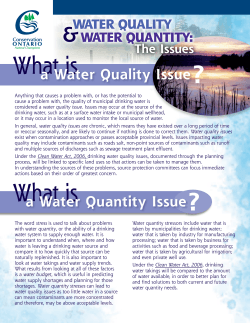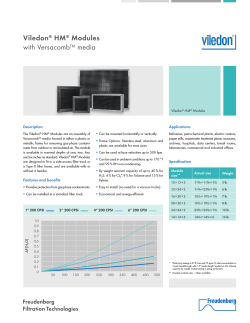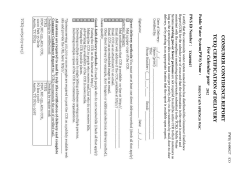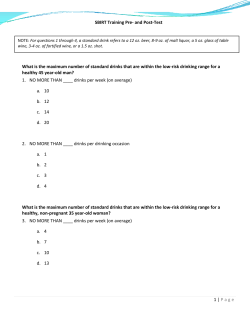
2014 Consumer Confidence Report Department of Water Utilities
City of San Angelo Department of Water Utilities 2014 Consumer Confidence Report (Year 2013 Data) WHY HAVE I RECEIVED THIS REPORT? In 1996, Congress amended the Safe Drinking Water Act to include a requirement that water utilities annually notify customers about their drinking water quality. This report is produced annually by the Department of Water Utilities to provide information about the San Angelo water system, source water, levels of minerals and any detected contaminants, and to ensure compliance with applicable TCEQ rules and regulations. We hope this report will also help answer any questions you may have about our water system and quality. The Department of Water Utilities is part of your city government. If you have questions about this report, you may contact us by telephone or mail: Department of Water Utilities 72 W. College Ave. San Angelo, Texas 76903 325.657.4209 http://www.cosatx.us If you would like the opportunity to participate in decisions that may affect the quality of our water, you may attend a regularly scheduled City Council Meeting at the McNeese Convention Center on the first and third Tuesday of the month. San Angelo Water System Facts Total Year Pumpage (Billion Gallons) Daily Treatment Capacity (Million Gallons) Maximum Daily Usage (Million Gallons) Average Daily Usage (Million Gallons) Average Person Usage (Gallons Daily) Distribution System (Miles) Service Connections (Water Meters) Population 2011 5.75 42 27 17 177 656 37,229 93,200 2012 4.53 42 21 14 150 672 38,948 94,544 2013 4.30 42 19 13 132 750 39,804 95,887 Este reporte incluye información importante sobre el agua para tomar. Para asistencia en Español, favor de llamar al telefono (325) 657-4209. Page 1 of 9 WHERE DOES OUR WATER COME FROM? San Angelo currently has six surface water sources: Twin Buttes Reservoir, O.C. Fisher Lake, Lake Nasworthy, O.H. Ivie Reservoir, E.V. Spence Reservoir, and the South Concho River. San Angelo currently gets its source water from O.H. Ivie Reservoir or the South Concho River, which is fed by Twin Buttes and Lake Nasworthy. O.H. Ivie Reservoir is typically the primary source. However, on occasion the South Concho River is used as the primary source. Occasionally, the two source waters are blended. In April 2014, the Hickory Aquifer groundwater became available as an additional water source. An ion exchange water treatment plant to remove radium and iron from the Hickory groundwater is scheduled to be completed in November 2014. Prior to its completion, the TCEQ has granted permission to blend the Hickory water with surface water at a 1:5 ratio. Hickory water wells have an average 25 pCi/L of radium. Blending this water with surface water at or below a 1:5 ratio will ensure the radium levels in the finished drinking water remain below the 5 pCi/L TCEQ regulatory limit. HOW IS OUR WATER USED? Residential Commercial Industrial Institutional Wholesale 69% 15% 7% 6% 3% SPECIAL HEALTH INFORMATION The following information is not meant to alarm or scare you. It is meant to make you aware. The exact wording shown below is required by state regulations. "You may be more vulnerable than the general population to certain microbial contaminants, such as Cryptosporidium, in drinking water. Infants, some elderly, or immunocompromised persons such as those undergoing chemotherapy for cancer; those who have undergone organ transplants; those who are undergoing treatment with steroids; and people with HIV/AIDS or other immune system disorders can be particularly at risk from infections. You should seek advice about drinking water from your physician or health care provider. Additional guidelines on appropriate means to lessen the risk of infection by Cryptosporidium are available from the Safe Drinking Water Hotline at (800) 426-4791." TTHMs (Total Trihalomethanes). Some people who drink water containing trihalomethanes in excess of the MCL over many years may experience problems with their liver, kidneys, or central nervous systems, and may have an increased risk of getting cancer. Page 2 of 9 CURRENT 2014 CAPITAL PROJECTS Replace approximately 20,000 feet of water mains; $1.3 million. Replace 3,000 feet of sewer mains along Concho River; $2.1 million. Hickory Groundwater Treatment Facility, estimated $27 million. Hickory Well Field Expansion, Phase 1, $7.5 million. Hickory Well Field Expansion, Phase 2, $9.7 million. PROJECTS PLANNED FOR 2015 Replace approximately 20,000 feet of water mains; $1.3 million. Replace 5,000 feet of sewer mains along Concho River; $4.0 million. Replace large valves on transmission pipelines; $0.5 million. Replace 3,500 feet of sewer mains in Sulfur Draw; $4.5 million. Alan Plummer Associates will complete a study for reuse of reclaimed wastewater. WHY DO WE CHANGE OUR DISINFECTION PROCESS EACH YEAR FROM CHLORAMINES TO FREE CHLORINE? Surface water sources, such as O.H. Ivie and the South Concho River, typically contain dissolved organic compounds that react with free chlorine during disinfection to form unwanted by-products called trihalomethanes (THMs). To reduce the production of THMs, liquid ammonium sulfate is added at the time of chlorination so it will combine with the chlorine to form chloramines. This is done specifically to reduce and control the production of THMs. As chloramine moves through the distribution system and provides disinfection of the water, it partially decays and releases ammonia. Over time, the ammonia can cause unwanted side effects such as nitrification and biofilm. Periodically the disinfectant must be changed back from chloramines to free chlorine to help control nitrification and reduce the biofilm. This typically takes about four weeks to accomplish. During this time, chlorine dosage levels at the treatment plant are not increased and are often reduced. Free chlorine has a much lower threshold of odor than chloramines so the water may smell like it has more chlorine in it when it actually doesn't. DON'T POUR IT DOWN THE DRAIN - FATS, OILS, GREASE, SOLIDS These materials are generated during food preparation. They don't mix well with water. When flushed, these materials can build up and block the entire sewer pipeline and cause raw sewage overflows into your home, lawn, streets, parks and rivers. Never pour fats, oil, grease or food scraps into your sink, garbage disposal or toilet. It is best to place as much of these type wastes as you can into your garbage. Page 3 of 9 WATER CONSERVATION TIPS • • • • • When filling your bathtub, plug the tub before turning the water on and then adjust the temperature as the tub fills up. Fix your leaky faucets as soon as they are discovered. It is simple and inexpensive. Install a rain shut-off device on your automatic sprinklers to eliminate unnecessary watering. Try and do at least one thing each day that saves water. Even if the savings are small, every drop counts. When watering your lawn, do not allow your water to run off property to a gutter, street, alley, or drainage for a distance of more than 150 feet. CURRENT DROUGHT LEVEL AS OF THIS PRINTING - LEVEL II • • • • • • • • Watering your lawn is allowed no more than once every seven days with total applications not exceeding one inch per week. No exceptions for more frequent watering of new landscapes. Watering is prohibited from noon to 6 p.m., when evaporation rates are highest. Golf course greens may be watered daily except during prohibited watering hours. Drip irrigation and hand watering are allowed on any day, so long as the total amount of water used does not exceed 1 inch per week. Drip irrigation may occur at any time of day. Hand watering is prohibited from noon to 6 p.m. Water may not run more than 150 feet down any gutter, street, alley or ditch. Excessive use fees are applied for residential usage in excess of 10,000 gallons per billing period. The ordinance is scheduled to be reevaluated July 1, 2014. WHAT EFFECT WILL THE HICKORY AQUIFER HAVE ON OUR WATER QUALITY? The Hickory Aquifer water contains low levels of Radium226 and Radium228. An ion exchange system to remove radium is currently being built and is scheduled to be online November, 2014. Once radium is removed, the groundwater will be blended with existing surface water sources. The Hickory Aquifer water has a much lower mineral and organic content than the city’s surface water sources. Utilizing this water will result in a lower overall total mineral content of the finished water. The lower levels of organic material in the water will also help lower the formation of trihalomethanes (THMs) during the disinfection process. A WORD ABOUT LEAD AND COPPER If present, elevated levels of lead can cause serious health problems, especially for young children and pregnant women. Lead in drinking water comes primarily from materials used in home plumbing, fixtures and service lines. This water supply is responsible for providing water with acceptable low levels of lead, however cannot control the Page 4 of 9 variety of materials used in plumbing components. When your water has been sitting for several hours, you can minimize the potential for elevated levels of lead by flushing your tap for 30 seconds to 2 minutes before using water for drinking or cooking. CHLORAMINE DISINFECTION San Angelo uses a mixture of chlorine gas and liquid ammonium sulfate for disinfection. When combined, chloramine is formed. Chloramine is primarily composed of monochloramine, with much lesser levels of dichloramine and trichloramine. For a four week period around June of each year, the disinfection process is changed to free chlorine for routine maintenance of the distribution system. State and Federal Standards Substance (units) Chloramines (ppm) MCLG 4 MRDLG MCL 4 MRDL Levels Measured in San Angelo Water Average Minimum Maximum Level Level Level Detected Detected Detected 2.83 0.5 5.4 Possible Source Disinfectant used to control microbes MCLG (Maximum Contaminant Level Goal) - The level of a contaminant in drinking water below which there is no known or expected risk to health. MCLGs allow for a margin of safety. MCL (Maximum Contaminant Level) - The highest level of a contaminant that is allowed in drinking water. MCLs are set as close to maximum contaminant level goals as feasible using the best available treatment technology. MRDLG (Maximum Residual Disinfectant Level Goal)- The level of a drinking water disinfectant below which there is no known or expected risk to health. MRDLGs do not reflect the benefits of the use of disinfectants to control microbial contaminants. MRDL (Maximum Residual Disinfectant Level) - The highest level of a disinfectant allowed in drinking water. There is convincing evidence that addition of a disinfectant is necessary for control of microbial contaminants. MRDL and MRDLG are based on a monthly average. There is no violation to occasionally exceed 4.0 mg/L chlorine residual on a given day. FACTS ABOUT TRIHALOMETHANE'S (THMs) When chlorine is added to source water containing dissolved organics, undesirable by-products are often formed called trihalomethanes (THMs). THMs are a common problem with most all surface water treatment plants and can form at the treatment plant and in the distribution system. Warmer water temperature in the summer and longer water residence time in the distribution lines due to conservation measures can enhance the formation of THMs in our water. Water lines must routinely be flushed to remove stagnant water to prevent the formation of THMs, especially during periods of elevated conservation. It may appear that water is being unnecessarily wasted by flushing lines, but this must be done to prevent the formation of THMs. The regulatory limit for THMs is 80 ppb. San Angelo had no violations for THMs in 2013 (see table below). Page 5 of 9 Sample Site DBP2-01 DBP2-02 DBP2-03 DBP2-04 DBP2-05 DBP2-06 DBP2-07 DBP2-08 Q1 2/4/13 7.90 27.10 6.00 6.20 22.20 17.00 9.10 42.20 2013 THM Quarterly Testing - Results in ppb Q2 Q3 Q4 4/23/13 9/9/13 11/21/13 12.60 8.96 27.30 13.30 12.70 15.80 12.40 9.04 15.30 27.90 12.30 17.30 15.20 11.00 15.30 19.50 11.40 19.30 14.00 11.60 19.70 12.70 11.90 18.80 Annual Average 14.19 17.23 10.69 15.93 15.93 16.80 13.60 21.40 Some people who drink water containing trihalomethanes in excess of the MCL over many years may experience problems with their liver, kidneys, or central nervous systems, and may have an increased risk of getting cancer. The TCEQ completed an assessment of your source water and results indicate that some of your sources are susceptible to certain contaminants. The sampling requirements for your water system are based on this susceptibility and previous sample data. Any detections of these contaminants may be found in this Consumer Confident Report. The sources of drinking water (both tap and bottled water) include rivers, lakes, streams, ponds, reservoirs, springs, and wells. As water travels over the surface of the land or through the ground, it dissolves naturally occurring minerals and, in some cases, radioactive material, and can pick up substances resulting from the presence of animals or from human activity. Contaminants that may be present in source water include: (1) microbial contaminants, such as viruses and bacteria, which may come from sewage treatment plants, septic systems, agricultural livestock operations, and wildlife; (2) inorganic contaminants, such as salts and metals, which can be naturally occurring or result from urban storm water runoff, industrial or domestic wastewater discharges, oil and gas production, mining, or farming; (3) pesticides and herbicides, which might have a variety of sources such as agriculture, urban storm water runoff, and residential uses; (4) organic chemical contaminants, including synthetic and volatile organic chemicals, which are byproducts of industrial processes and petroleum production, and can also come from gas stations, urban storm water runoff, and septic systems; (5) radioactive contaminants, which can be naturally occurring or the result of oil and gas production and mining activities. In order to ensure that tap water is safe to drink, the EPA prescribes regulations that limit the amount of certain contaminants in water provided by public water systems. Food and Drug Administration regulations establish limits for contaminants in bottled water that must provide the same protection for public health. Contaminants may be found in drinking water that may cause taste, color, or odor problems. These types of problems are not necessarily causes for health concerns. Drinking water, including bottled water, may reasonably be expected to contain at least small amounts of some contaminants. The presence of contaminants does not necessarily indicate that water poses a health risk. More information about contaminants and potential health effects can be obtained by calling the EPA Safe Drinking Water Hotline at (800) 426-4791. For more information on source water assessments and protection efforts at our system, contact Kevin Krueger, Assistant Director of Water Utilities, 325.657.4209. Page 6 of 9 REGULATED CONTAMINANTS DETECTED Coliform Bacteria Maximum Contaminant Level Goal Total Coliform Maximum Contaminant Level 0 5% of monthly samples are positive. Highest No. Fecal Coliform or E. Total No. of of Positive Coli Maximum Positive E. Contaminant Level Coli or Fecal Coliform Samples 1.9 0 Violation Likely Source of Contamination N Naturally present in the environment. Lead and Copper Date Sampled MCLG Action Level (AL) 90th Percentile Copper 2013 1.3 1.3 0.152 0 ppm N Erosion of natural deposits; Leaching from wood preservatives; Corrosion of household plumbing systems. Lead 2013 0 15 4.89 0 ppb N Corrosion of household plumbing systems; Erosion of natural deposits. Lead and Copper # Sites Over Units AL Violation Likely Source of Contamination Other Regulated Contaminants Disinfectants and Disinfection By-Products Collection Date Haloacetic Acids (HAA5)* 2013 14 Total Trihalomethanes (TTHM) 2013 16 Inorganic Contaminants Collection Date Highest Level Range of Levels Detected Detected MCLG MCL Units 5.6 - 28 No goal for the total 60 ppb N By-product of drinking water disinfection. 0 - 42.2 No goal for the total 80 ppb N By-product of drinking water disinfection. MCLG MCL Units Highest Level Range of Levels Detected Detected Violation Likely Source of Contamination Violation Likely Source of Contamination Antimony 2013 0.385 0.385 - 0.385 6 6 ppb N Discharge from petroleum refineries; fire retardants; ceramics; electronics; solder; test addition. Arsenic 2013 3 2.65 - 2.65 0 10 ppb N Erosion of natural deposits; Runoff from orchards; Runoff from glass and electronics production wastes. Barium 2013 0.172 0.172 - 0.172 2 2 ppm N Discharge of drilling wastes; Discharge from metal refineries; Erosion of natural deposits. Chromium 2013 0.957 0.957 - 0.957 100 100 ppb N Discharge from steel and pulp mills; Erosion of natural deposits. Fluoride 2013 0.3 0.29 - 0.29 4 4.0 ppm N Erosion of natural deposits; Water additive which promotes strong teeth; Discharge from fertilizer and aluminum factories. Page 7 of 9 Nitrate [measured as Nitrogen] 2013 0.46 0.18 - 0.46 10 10 ppm N Runoff from fertilizer use; Leaching from septic tanks, sewage; Erosion of natural deposits. Nitrite [measured as Nitrogen] 2013 1 0.004 – 0.004 1 1 ppm N Runoff from fertilizer use; Leaching from septic tanks, sewage; Erosion of natural deposits. Selenium 2013 10 8.92 - 8.92 50 50 ppb N Discharge from petroleum and metal refineries; Erosion of natural deposits; Discharge from mines. MCLG MCL Units Radioactive Contaminants Collection Date Highest Level Range of Levels Detected Detected Violation Likely Source of Contamination Beta/photon emitters 06/22/2011 12.6 12.6 - 12.6 0 50 pCi/L* N Decay of natural and man-made deposits. Gross alpha excluding radon and uranium 6/22/2011 3.1 3.1 – 3.1 0 15 pCi/L N Erosion of natural deposits. Turbidity Limit (Treatment Technique) Level Detected Violation 1 NTU 0.26 NTU N Soil runoff. 0.3 NTU 100% N Soil runoff. Highest single measurement Lowest monthly % meeting limit Likely Source of Contamination UNREGULATED CONSTITUENTS Secondary Constituents Year Tested Average Level Detected Minimum Level Detected Maximum Level Detected Limit Bicarbonate (ppm) 2013 143 143 143 NA Erosion of natural deposits Chloride (ppm) 2013 505 505 505 300 Erosion of natural deposits, natural occurring element, ancient oceanic deposits pH (units) 2013 7.4 7.4 7.4 > 7.0 Sulfate (ppm) 2013 419 419 419 300 T Alkalinity as CaCO3 (ppm) 2013 117 117 117 NA Total Dissolved Solids (ppm) 2013 1550 1550 1550 1000 Substance (units) Possible Source Measure of corrosivity of the water Erosion of natural deposits, natural occurring Erosion of natural deposits, natural occurring Page 8 of 9 Erosion of natural deposits, total dissolved mineral constituents in water UCMR3 Unregulated Constituents Year Collected Entry Point Sample MR Point Sample Maximum Reportable Level (MRL) Units Bromochloromethane 2013 150/220 ND/ND 60 ng/L Molybdenum 2013 6.1/4.3 6.5/4.7 1 µg/L Stontium 2013 2000/1800 2100/1900 0.3 µg/L Vanadium 2013 ND/0.25 0.38/0.33 0.2 µg/L Hexavalent Chromium (Dissolved) 2013 0.035/ND 0.038/ND 0.03 µg/L Substance UCMR3 unregulated contaminants are those for which the EPA has not established drinking water standards. The purpose of the unregulated contaminant monitoring is to assist EPA in determining the occurrence of unregulated contaminants in drinking water and whether future regulations are warranted. MCLG (Maximum Contaminant Level Goal) - The level of a contaminant in drinking water below which there is no known or expected risk to health. MCLGs allow for a margin of safety. MCL (Maximum Contaminant Level) - The highest level of a contaminant that is allowed in drinking water. MCLs are set as close to maximum contaminant level goals as feasible using the best available treatment technology. MRDLG (Maximum Residual Disinfectant Level Goal) - The level of a drinking water disinfectant below which there is no known or expected risk to health. MRDLGs do not reflect the benefits of the use of disinfectants to control microbial contaminants. MRDL (Maximum Residual Disinfectant Level) - The highest level of a disinfectant allowed in drinking water. There is convincing evidence that addition of a disinfectant is necessary for control of microbial contaminants. mrem/year--millirems per year (a measure of radiation absorbed by the body) NTU--nephelometric turbidity units (a measure of turbidity) pCi/L--picocuries per liter (a measure of radioactivity) ppb--parts per billion, or micrograms per liter (µ/L) ppm--parts per million, or milligrams per liter (mg/L) ppt--parts per trillion, or nanograms per liter (ng/L) ppq--parts per quadrillion, or picograms per liter (pg/L) TT (Treatment technique) -A required process intended to reduce the level of a contaminant in drinking water. AL (Action Level) - The concentration of a contaminant which, if exceeded, triggers treatment or other requirements that a water system must follow. ALG (Action Level Goal) – The level of a contaminant in drinking water below which there is no known or expected risk to health. ALGs allow for a margin of safety. ND - no detection NA - not applicable Note: Unregulated contaminants are those for which the EPA has not established drinking water standards. The purpose of unregulated contaminant monitoring is to assist EPA in determining the occurrence of unregulated contaminants in drinking water and whether future regulations are warranted. Data presented in this report is from the 2013 calendar year or from the most recent testing performed in accordance with State regulations. The 90th percentile value means 90% of the samples were at or below this value. EPA considers the 90th percentile value the same as an "average" value for other contaminants. Lead and copper are regulated by a treatment technique that requires systems to control the corrosiveness of their water. If more than 10% of tap water samples exceed the action level, water systems must take additional steps. EPA considers 50 pCi/L to be the level of concern for beta particles. - Document End - Page 9 of 9
© Copyright 2025














